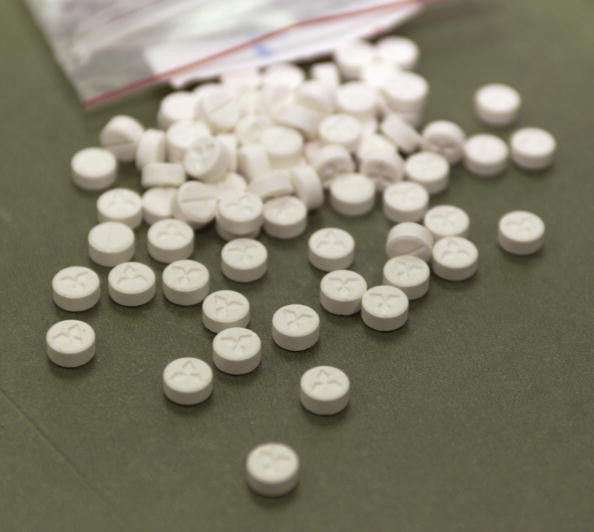How MDMA can help patients suffering from PTSD
On World Mental Health Day, IBTimes UK looks at the effects of MDMA on patients with PTSD.

Shell-shocked soldiers with blank expressions, harrowing nightmares and distressing memories from childhood trauma – these are the images conjured up by post-traumatic stress disorder (PTSD). For those affected, the path to recovery is often long and tortuous.
The torments caused by PTSD were first documented in the World War I, when the horrific conditions of warfare in the trenches ended up hurting a large number of fighters. However, the official recognition of the condition as a mental health disorder came much later – it was first introduced in the Diagnostic and Statistical Manual of Mental Disorders in 1980.
To mark World Mental Health Day (celebrated on 10 October), IBTimes UK shines a light on this devastating disease, which according to the World Health Organisation affects roughly 3.6% of the global population.
Investigating new treatments
Triggered by very stressful or distressing experiences, PTSD tends to develop in the months that follow the trauma, although some people start experiencing the condition many years later. Re-experiencing the trauma through flashbacks, nightmares, repetitive and distressing images or uncomfortable physical sensations is a common symptom. Many patients also experience emotional numbness, which cuts them off from their loved ones.
The recommended treatment for PTSD is psychotherapy, but in more severe cases antidepressants can be prescribed. Recently however, clinicians have increasingly come to recognise that there are limits to therapy, and that novel approaches and new compounds may be required.
" We need to adopt a symptom-based approach to treat PTSD before getting these patients into therapy", Eric Vermetten, professor of psychiatry at Leiden University, told IBTimes UK. If patients lose sleep because of nightmares, they will not be fresh for therapy and may not benefit from it. That is an indication that we need to do something. We need to reduce the occurrence of nightmares and get them 'fresh'".
Recently, treatment research has gone through profound changes as physicians have began investigating original therapeutic strategies in order to help treatment-resistant PTSD sufferers. The most promising, and perhaps most controversial, has been to test the effects of MDMA to see if it could improve therapy outcomes, and if so, how.
The case for using MDMA
MDMA was first synthesised in 1912 by the Merck pharmaceutical company. It only became associated with recreational drugs decades later, when pharmacologist Alexander Shulgin tested MDMA on himself in 1976. Following his experiments, some psychotherapists began giving the compound to their patients in order to assist therapy and to make it more efficient. Results were promising, but in parallel, MDMA also became popular as a recreational drug, known by users as 'ecstasy'.
To curb recreational consumption, the US Drug Enforcement Administration (DEA) banned MDMA in 1985. In the UK, the 1971 Misuse of Drugs Act listed ecstasy as a controlled drug.

But scientists battle to improve therapy for PTSD patients, and MDMA has slowly resurfaced as a compound worth investigating for the benefits it may bring, when administered in strictly controlled medical settings.
Since PTSD is emotionally numbing for many patients, a lot of them have trouble opening up to their therapists and trusting them enough to make the treatment effective.
"Chronic PTSD sufferers avoid, they don't want to talk about their trauma and they gradually lose their capacity to experience emotions. Their whole life is then going to be built around suppressing, avoiding and downplaying their symptoms. That costs a lot of energy and when they come into psychotherapy, it can be very hard to get them to open up and talk. What MDMA can do is make people feel more tolerant, more open. It may then be possible to reach them", said Vermetten.
One of the most important studies on the subject was conducted in 2012 by scientists from Imperial College in London, and published in the journal Biological Psychiatry. With the help of functional MRI scans, researchers led by Prof David Nutt showed how the drug acts on the brain of healthy volunteers.
MDMA appeared to decrease activity in the limbic system – a set of structures involved in emotional responses – and to increase communication between brain regions involved in emotional control. This is the complete opposite pattern to the one observed in the brains of people suffering from anxiety. Furthermore, MDMA also increased communication between the amygdala and the hippocampus – an interesting find as there is evidence that such communication is reduced in PTSD patients.
The researchers also asked participants to recall their favourite and worst memories while inside the scanner. After receiving MDMA in the context of a double-blind, placebo controlled trial, their worse memories were described as less negative and their positive memories as more vivid. This was reflected in the way that parts of the brain were activated. These findings are published in the International Journal of Neuropsychopharmacology.

Previously, a pilot study in the US of 20 PTSD patients had shown that MDMA-assisted therapy was safe and effective. Two months after receiving therapy sessions aided by the drug, 83% of participants who had received MDMA non longer met the criteria for PTSD vs. only 25% of those who had been given a placebo.
Overall, these different studies point to the beneficial effects of MDMA on the brain - reducing the negative effects of PTSD and making therapy more successful. Phase 2 clinical trials of MDMA-assisted psychotherapy for PTSD are currently being conducted or planned in South Carolina, Colorado, Canada and Israel.
Addressing ethical challenges
There are obvious ethical concerns when testing a drug which is often associated with recreational use. Detractors of this kind of research point out that using MDMA could encourage people to try it 'on the street', without the control of a doctor.
At this point, it is crucial to emphasise that recreational drugs ecstasy is often mixed with unknown and potentially dangerous substances, while MDMA given in the lab is a pure compound. It is given in controlled doses following a strict experimental protocol.
The idea of this type of research is not to encourage PTSD patients to self-medicate, but to open up an avenue where they would be prescribed MDMA in controlled settings, in combination with therapy. In addition, it is worth mentioning that MDMA has a very low addictive potential.
"It is difficult to pass on the message that we are recommending such a drug as treatment, but that we are not pushing people to take recreational drugs. We are merely investigating how clinicians can help PTSD patients, and larger, more rigorous studies will ultimately show the benefits for patients and help us use MDMA as a therapeutic option", Vermetten concluded.
© Copyright IBTimes 2025. All rights reserved.





















